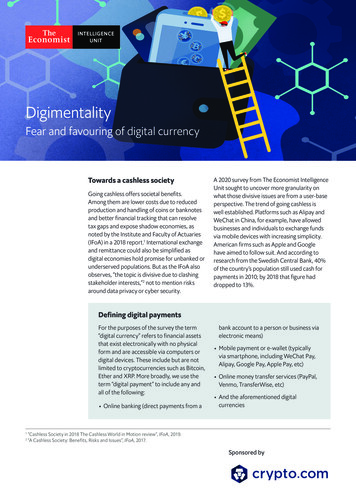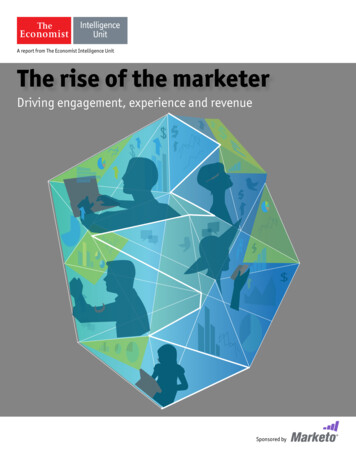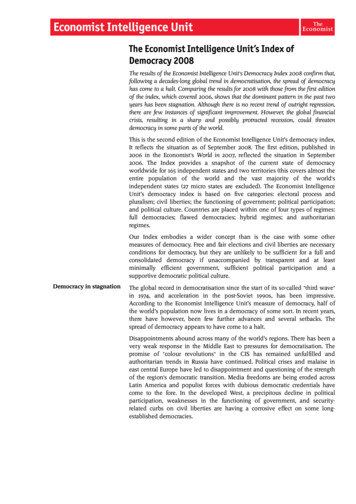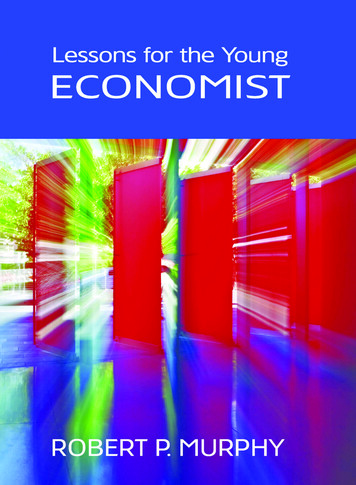
Transcription
DigimentalityFear and favouring of digital currencyTowards a cashless societyGoing cashless offers societal benefits.Among them are lower costs due to reducedproduction and handling of coins or banknotesand better financial tracking that can resolvetax gaps and expose shadow economies, asnoted by the Institute and Faculty of Actuaries(IFoA) in a 2018 report.1 International exchangeand remittance could also be simplified asdigital economies hold promise for unbanked orunderserved populations. But as the IFoA alsoobserves, “the topic is divisive due to clashingstakeholder interests,”2 not to mention risksaround data privacy or cyber security.A 2020 survey from The Economist IntelligenceUnit sought to uncover more granularity onwhat those divisive issues are from a user-baseperspective. The trend of going cashless iswell established. Platforms such as Alipay andWeChat in China, for example, have allowedbusinesses and individuals to exchange fundsvia mobile devices with increasing simplicity.American firms such as Apple and Googlehave aimed to follow suit. And according toresearch from the Swedish Central Bank, 40%of the country’s population still used cash forpayments in 2010; by 2018 that figure haddropped to 13%.Defining digital paymentsFor the purposes of the survey the term“digital currency” refers to financial assetsthat exist electronically with no physicalform and are accessible via computers ordigital devices. These include but are notlimited to cryptocurrencies such as Bitcoin,Ether and XRP. More broadly, we use theterm “digital payment” to include any andall of the following: Online banking (direct payments from a12bank account to a person or business viaelectronic means) Mobile payment or e-wallet (typicallyvia smartphone, including WeChat Pay,Alipay, Google Pay, Apple Pay, etc) Online money transfer services (PayPal,Venmo, TransferWise, etc) And the aforementioned digitalcurrencies“Cashless Society in 2018 The Cashless World in Motion review”, IFoA, 2019.“A Cashless Society: Benefits, Risks and Issues”, IFoA, 2017.Sponsored by
DigimentalityFear and favouring of digital currency"We see that the trend is strong," says EvaJulin, deputy head general secretariat atSveriges Riksbank, Sweden’s Central Bank,who leads the country’s evaluation of issuing adigital currency. "Paying with cash in Swedencan actually be difficult; our legal systemgives businesses the right to refuse physicalpayments." As a result, the country’s hotels,restaurants, stores—and, ironically, bankoffices—are becoming “cash free”.Overall, 64% of survey respondents reportusing digital payments for over half of theirpurchases instead of physical banknotes, coinsor credit cards in the past 12 months. Almostone in five (20%) said they had not used adigital payment in the past year but plan to doso over the next 12 months, indicating furthergrowth.Figure 1: Often digitalFrequency of making digital payments instead of using physical banknotes, coins or credit cards(% respondents)22%Always (as close to 100% of purchases as possible)Often (at least 50% of purchases)42%Sometimes (less than 50% of purchases)23%Rarely (less than 10% of purchases)Never14%0%Source: The Economist Intelligence Unit.Cash outResults of our global survey of over 3,000users of digital payments show that 10% ofrespondents believe their own country isalready cashless (defined as predominantlyusing digital instead of physical paymentmethods). Trends of mobile penetration rates3and tech innovation indicate there is still muchroom for these numbers to increase.In the next 12 months, almost a third (28%)of survey respondents believe they are“extremely likely” to use digital payments formost or all of their daily transactions insteadof cash. Another third say they are “very likely”to do so. On average only 4% say they are “notat all likely”. Isolating results to respondents indeveloping economies cuts that rate to 1%.Figure 2: Digital progressRespondents’ likeliness to use digital payments for daily transactions instead of cash(% respondents)28%Extremely likelyVery likely32%Somewhat likely23%Not very likely11%Not at all likelyDon’t know4%2%Source: The Economist Intelligence Unit.35.1bn people around the world subscribed to mobile services, accounting for 67% of the global population as at 2019, according to GSMA Intelligence The Economist Intelligence Unit Limited 20202
DigimentalityFear and favouring of digital currencyOur survey indicates greater resistance togoing cashless in developed economies. Morerespondents in these countries predict theirsociety will never become cashless than thosein developing ones. The latter also expressedmore optimism that cashless systems woulddevelop faster. Similarly, younger people(aged 18 to 38) are more inclined thanolder peers (aged 39 and above) to expecta cashless society. The emerging trend ofwho fears and favours digital transactions isnot surprising when compared with mobileinternet usage. According to the Pew ResearchCentre, younger generations (aged 18 to 34)are far more likely to own a smartphone.4And studies from Statcounter, an analyticsfirm, show developing economies such asIndia, Indonesia, Turkey and China are worldleaders in terms of internet usage from mobilephones.5 As transacting digitally becomesmore of a norm, these stats are likely to be keyfactors in how digital currency will evolve.Digital Currencies: Growing choice of optionsGovernment-backed cash (also knownas fiat currency) has long dominatedthe payment landscape. But rapidtechnological change has led to a hostof alternatives led by credit, then digital(including online banking or smartphoneapps) and finally cryptocurrency options.of new cryptocurrencies based onsimilar underlying technology are beingdeveloped by financial and technologyorganisations—most notably Libra, socialmedia company Facebook’s marketoffering. However, these have yet to beimplemented in practice.Central-bank digital currency (CBDC) andcommercially backed digital options arethe next development.Governments see an opportunity to issuedigital currencies that fill a void, ensuringtrust by virtue of their backing whileretaining the advantages of crypto-likesystems. Therefore, Central Banks aroundthe world have started tinkering withdigital versions of their existing physicalcurrencies. CBDCs are still in trial stagesand currently unavailable to the generalpublic.Cryptocurrencies based on Blockchainwith no backing from commercialor government entities (such asBitcoin) are perhaps the best-knowndecentralised systems, but differentplayers are starting to pile on. A rangeFear and favouring of digitalcurrenciesDespite many new digital ways to pay, surveyrespondents still report the most commonform of payment they use is a physical credit45or debit card. The second most-preferredoption is online banking, with cash comingnext. Cryptocurrencies, reflecting theaforementioned divisiveness, come last.Only 5% of survey respondents say that they“always” use them; 10% say they do so “often”.“Smartphone Ownership Is Growing Rapidly Around the World, but Not Always Equally”, Pew Research Centre, 2019.“India amongst world leaders in use of mobile to surf the internet”, Statcounter, March 2017. The Economist Intelligence Unit Limited 20203
DigimentalityFear and favouring of digital currencyFigure 3: Cash uncrownedUse frequency for payment methods(% respondents)More than 50% of purchasesLess than 50% of purchasesNever (but plan to use in the next 12 months)Physical credit or debit cards69%Online banking49%Cash (physical banknotes and coins)42%Online money transfer services36%Mobile payment or e-wallet32%Stored value card16%Digital currencies (cryptocurrenciessuch as Bitcoin, Ether, XRP, etc.)15%Never (and don’t plan to use)Don’t 1%3%12%15%20%6% 3%4%9%7%Source: The Economist Intelligence Unit.Yet digital currencies are capturing mediaheadlines with China proposing a CBDC pilotprogramme in 2020 and tech and financialfirms floating new concepts in the space(such as Facebook’s Libra or the blockchainbased JPM Coin from J. P. Morgan, a largeinvestment bank). However, for surveyrespondents, cryptocurrencies are still themost commonly recognised form of digitalcurrency. Cryptocurrency awareness indeveloped economies reached 79% (92%in developing ones, with an overall surveyaverage of 85%). But developing economiesshow greater affinity: 41% claim ownershipand 23% usage. In developed markets, only19% claim ownership and 9% usage—all in, theaverage is 16%.“Digital currencies are preferred overphysical cash by some population groups,”says Antony Lewis, author of The Basics ofBitcoins and Blockchains: An Introduction toCryptocurrencies and the Technology thatPowers Them. “You need some fundamentalskills and competencies to deal with digitalcurrencies, and not everyone has these.”Survey results tend to reinforce this view.Respondents with university or higher degreeswere more than twice as likely to reporthaving used cryptocurrencies than those witha high school diploma or vocational training. The Economist Intelligence Unit Limited 20204
DigimentalityFear and favouring of digital currencyFigure 4: Byte smartCryptocurrency use by education level(% respondents)Yes, I have used this type of currency22%University degree (BA or higher)High school, vocational degree or less9%Survey average16%Source: The Economist Intelligence Unit.In terms of cryptocurrencies specifically, MsJulin also holds that they "are volatile andcan be seen as high-risk," commenting thatcryptocurrencies may be used as speculativeinvestments rather than for daily purchases.About a quarter (24%) of survey respondentsconcur, seeing short-term investment as acentral use. "Traders like cryptocurrenciesbecause of their volatility," agrees Mr Lewis.But he adds that using them for paymentholds promise for the financial inclusionof people who are currently unbankedgiven that traditional financial institutionsmay limit access due to reputational risk."Cryptocurrencies mean greater volatility butalso greater acceptability."Survey respondents came closer to sidingwith Mr Lewis with the largest share(34%) considering online payments to becryptocurrency’s main function. Another 24%cited “general interest in it as a technology”as a reason for its use. On the lower end ofthe scale, only 12% considered remittancepayments to be a main driver for the use ofcryptocurrency. As both Mr Lewis and Ms Julinnote, this could be explored further in termsof financial inclusion of the unbanked. This, ofcourse, raises the issue of trust.Figure 5: Purchase primacyReasons for using a digital currency(% respondents)Primarily for online purchases/payments34%General interest in it as a technology24%Short-term investment (ie, speculction)24%Long-term investment23%Foreign exchange22%For fraudulent or illegal transactions21%As safe haven asset/digital gold20%Portfolio diversification16%Control of own data16%For remittanceDon’t know12%11%Source: The Economist Intelligence Unit. The Economist Intelligence Unit Limited 20205
DigimentalityFear and favouring of digital currencyEven cash doesn’t score 100% ontrustworthiness in the survey. Among digitalcurrencies, 54% of respondents cited thatgovernment issuance could be a trust factor.“CBDC are very different beasts,” explainsMr Lewis. “CBDC is the least risky form ofelectronic payment,” yet he points out that apublicly available one doesn’t yet exist.“We see people want digital payments andwe have to follow this trend,” Ms Julin says. Tothat end, the Swedish Central Bank launchedan initiative in 2017 to evaluate potentialfor introducing the e-krona.6 “It is importantthat the government remains in the marketto ensure equal access to a trusted paymentoption,” Ms Julin adds. She believes CBDCsdecrease financial vulnerabilities in societyand can act as supplements to physical cash.Sweden may be an outlier but it’s not entirelyalone: other central banks are consideringfollowing suit. As previously noted, Chinaannounced a pilot programme to test itsCBDC during 2020.7 And in January this yearthe world Economic Forum announced aglobal consortium to develop governanceframeworks for digital currencies.8 TheInternational Telecommunications Union(ITU), a UN agency, also established a focusgroup on digital currency in 2017.9Figure 6: In Gov we trustSurvey respondent rating of trustworthiness(% respondents)Not trustworthyBalancedA decentralised digital currency such as acryptocurrency that is not backed by any 38%particular organisationDon’t know25%A digital currency issued by a large,23%international technology firm26%29%A digital currency issued by a large, 21%international financial firm29%A digital currency issued by my country’s14%government / central bankCash (physical banknotes and coins) from4%my own ource: The Economist Intelligence Unit.Hurdles aheadIn March 2020, the Louvre museum in Parisbanned cash at its ticket gate due to fearsthat banknotes could be covid-19 vectors.10The same caution has been taken globallyas China, South Korea and the US have alltaken steps to quarantine or remove cashfrom circulation. The central bank in SouthKorea has even burned banknotes in an effortto slow the virus outbreak.11 And a relatedstimulus package debated in the US CongressSveriges Riksbank Payments and cash notice; accessed March 20, 2020“China's new digital currency isn't bitcoin and not speculation”, South China Morning Post, December 22nd 2019.8“Governing the Coin: World Economic Forum Announces Global Consortium for Digital Currency Governance”, World Economic Forum, January 2020.9ITU Focus Group on Digital Currency including Digital Fiat Currency.10“No money for masterpieces: Louvre bans cash over virus fears”, Associated Press, March 4th 2020.11“S.Korea's central bank burns, quarantines cash in coronavirus precaution”, Reuters, March 6th 2020.67 The Economist Intelligence Unit Limited 20206
DigimentalityFear and favouring of digital currencyhas provisions to create a digital dollar.Covid-19 has unexpectedly presented a wholenew incentive to digitise money.But that doesn’t mean there aren’t stillbarriers. “Stakeholders have differentmotivations, and sometimes these compete,”says Mr Lewis, explaining that one’s gain canbe another's loss. “The card networks try tosay cash is bad,” but the reason for that, hesays, is that “they don’t make any money fromcash transactions.”In the survey, the top challenges hamperingwider adoption include the simple habit ofusing cash and data-privacy concerns. Dataprivacy also plays a major role when it comesto deciding whether to make any kind ofdigital payment: 61% of respondents rate it as“extremely important” while only 1% saw theissue as unimportant.Security, too, is a worry. One-third (32%) ofrespondents cite it as a concern, while Ms Julinhighlights cybercrime as the key challenge.But basic obstacles still exist, such as lowunderstanding of the technology (cited as themain barrier to adoption in the survey), as wellas there being too few options for actuallyusing a digital currency.Figure 7: Access controlImportance of data privacy in purchase decisions(% respondents)Extremely important61%Very important27%Somewhat importantNot very importantNot at all importantDon’t know10%1%0%1%Source: The Economist Intelligence Unit.Figure 8: More understanding neededBarriers to greater digital currency adoption(% respondents)Use of digital currencies is not well understood44%The technology is not secure32%There are too few options to use digital currencies28%They are mostly used for fraudulent or illegal transactions25%The procedure to buy digital currencies is too complicated25%It is difficult to know where to buy digital currencies25%There is no intrinsic value behind digital currencies22%It requires a secure form of personal digital ID, which doesn’t yet exist18%It is illegal to purchase some digital currencies in my countryOther (please specify)Don’t knowSource: The Economist Intelligence Unit.9%1%6% The Economist Intelligence Unit Limited 20207
DigimentalityFear and favouring of digital currencyMoving forwardpredict that businesses will have the biggestinfluence; an equal number cite consumers(36%). Again, governments come last (24%).Broadly, survey respondents see businessesrather than governments leading the way.Among those who say their country is alreadycashless, more than half (55%) believebusinesses have had the biggest influence,followed by consumers (24%). Governmentsget the least credit (19%). Among thosewho say their country is still on the way tobecoming cashless, about a third (36%) alsoThe overall trend points to greater acceptanceas well as more options in digital payments. “Iexpect more innovation coming out over thenext ten years,” says Mr Lewis. Users seemto have growing favour for cashless options,such as digital currencies, while businesses areobliging and governments are catching up.Figure 9: Big for businessSurvey respondents' ratings for which sector has the most influence on a country becoming cashless(% blic sectorDon’t know19%2%Source: The Economist Intelligence Unit.ConclusionIn summary, favour seems to outweigh fear.Survey results show that the concept of goingcashless is already broadly embraced witha variety of technologies taking the place ofphysical banknotes and coins—cash is only thethird most popular means of payment. Whatis yet to be seen is how currencies will evolvedigitally. A decade ago mobile paymentswere mostly theoretical as smartphonesthemselves were still new; now 32% of surveyrespondents say they use the platform for atleast half of their purchases. Digital currencies12are currently undergoing a heightened periodof public awareness (85% overall according tothe survey) and innovation as governmentsfrom China to Sweden experiment andbusinesses from tech to finance try newofferings.Support levels for digital currencies appearhigher in younger and developing-economypopulations paving the way for wider adoptionahead. As a parallel, it was these samepopulations that pushed mobile devices tobecome the dominant way the world goesonline today.12J Clement, “Mobile internet traffic as percentage of total web traffic in January 2020”, Statista, February 13th 2020. The Economist Intelligence Unit Limited 20208
DigimentalityFear and favouring of digital currencyKey takeaways Benefits of digital currencies includeimproved financial tracking, increasedfinancial inclusion and cost reductionsfrom reduced production and handlingof banknotes. The cashless trend is strong andbusinesses are seen as key drivers. Moreinnovation is likely as central banks, techfirms and financial firms enter the digitalcurrency field. Risks derive from issues of cybersecurity and data privacy. Familiarity with cryptocurrencies asthe first digital currency are high, yetmatters of trust, use options, andunderstanding persist. The Economist Intelligence Unit Limited 20209
DigimentalityFear and favouring of digital currencyAppendixD1. In what country are you personally located? Select one.(% respondents)Developed countries(US, UK, France, South Korea, Australia, and Singapore)50%Developing countries(Brazil, Turkey, Vietnam, South Africa, and the Philippines)50%Source: The Economist Intelligence Unit.D2. In what year were you born? Select one.(% respondents)18–38 years old61%39 years old and above39%Source: The Economist Intelligence Unit.D3. Which best represents your gender? Select one.(% respondents)Male62%Female38%Other0%Do not care to respond0%Source: The Economist Intelligence Unit.D4. Which range best describes your annual salary? Select one.(% respondents)Below median48%Above medianDo not care to answer49%4%Source: The Economist Intelligence Unit.D5. Which of the following best describes your educational background? Select one.(% respondents)Grammar to lower secondary school only2%High school, upper secondary or equivalent certificate23%Vocational/Technical school/Associate degree19%University graduate (BA, BS, etc)42%Master’s or other professional degree (MS, JD, MBA, etc)Professional doctorate (PhD, EdD, DSc, etc)Do not care to respondSource: The Economist Intelligence Unit.11%3%1% The Economist Intelligence Unit Limited 202010
DigimentalityFear and favouring of digital currencyAbout the reportDigimentality—Fear and favouringof digital currency is a report fromThe Economist Intelligence Unit,commissioned by Crypto.com, exploringthe extent to which digital payments aretrusted by consumers and what barriersmay exist to basic monetary functionsbecoming predominantly electronic ordigital.Kim Andreasson is the author and JasonWincuinas is the editor of this report. Theanalysis is based on a survey of 3,048people conducted in January and February2020. About half of the respondentscame from developed economies (US,UK, France, South Korea, Australia andSingapore) and half from developing ones(Brazil, Turkey, Vietnam, South Africaand the Philippines). About six in tenrespondents were between 18 and 38years old with the remaining aged 39 yearsor older. Roughly six in ten respondentswere male and four in ten were female.About half reported an above-medianannual salary and half said it was below.Various educational backgrounds arerepresented, with the largest numbersof respondents (four in ten) having acollege degree. All respondents hadbought a product or service within thepast 12 months using some kind of digitalpayment. Complete demographics can befound in the appendix.The following executives gave theirperspective for the report (listedalphabetically by surname): Eva Julin, deputy head generalsecretariat at Sveriges Riksbank(Sweden’s Central Bank) Antony Lewis, Fintech advisor to TheSecurities and Futures Commission(SFC) of Hong Kong; author of the bookThe Basics of Bitcoins and Blockchains:An Introduction to Cryptocurrenciesand the Technology that Powers Them;and blogger at bitsonblocks.netWe would like to thank all intervieweesand survey respondents for their time andinsight.While every effort has been taken to verify the accuracy of this information, The EconomistIntelligence Unit Ltd. cannot accept any responsibility or liability for reliance by any person onthis report or any of the information, opinions or conclusions set out in this report. The findingsand views expressed in the report do not necessarily reflect the views of the sponsor. The Economist Intelligence Unit Limited 202011
Online money transfer services Digital currencies (cryptocurrencies such as Bitcoin, Ether, XRP, etc.) Cash (physical banknotes and coins) Physical credit or debit cards Stored value card Online banking More than 50% of pur chases Source: The Economist Intelligence










